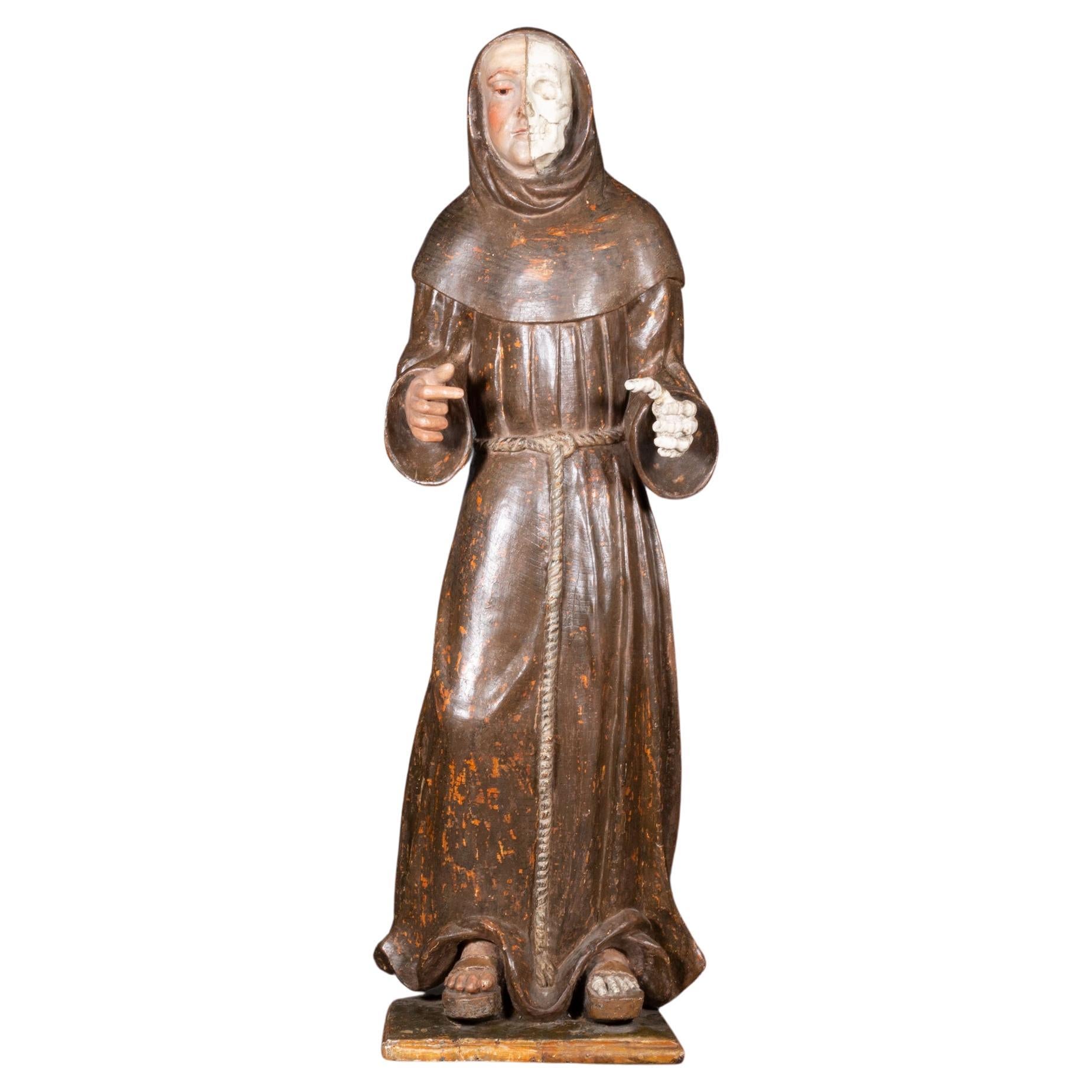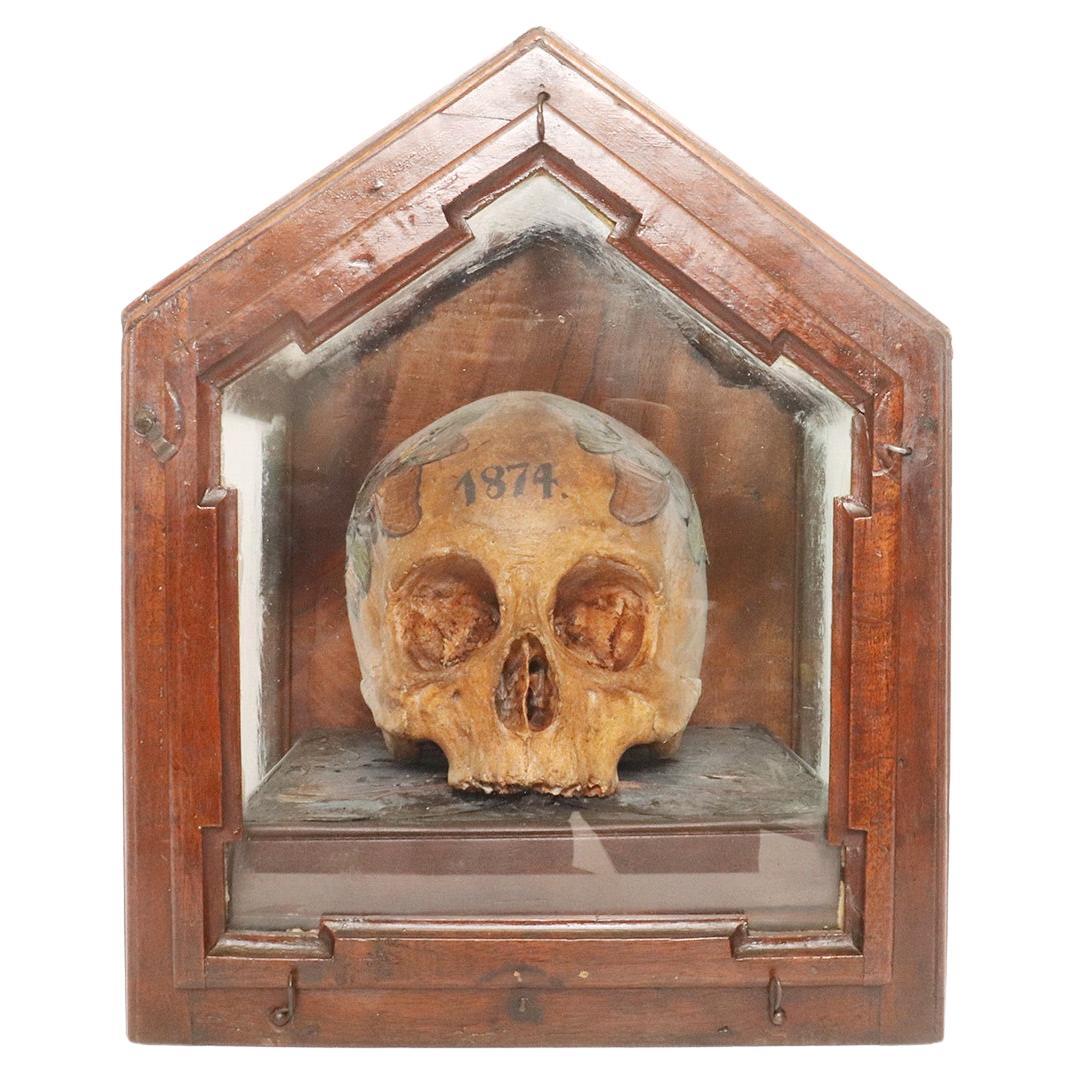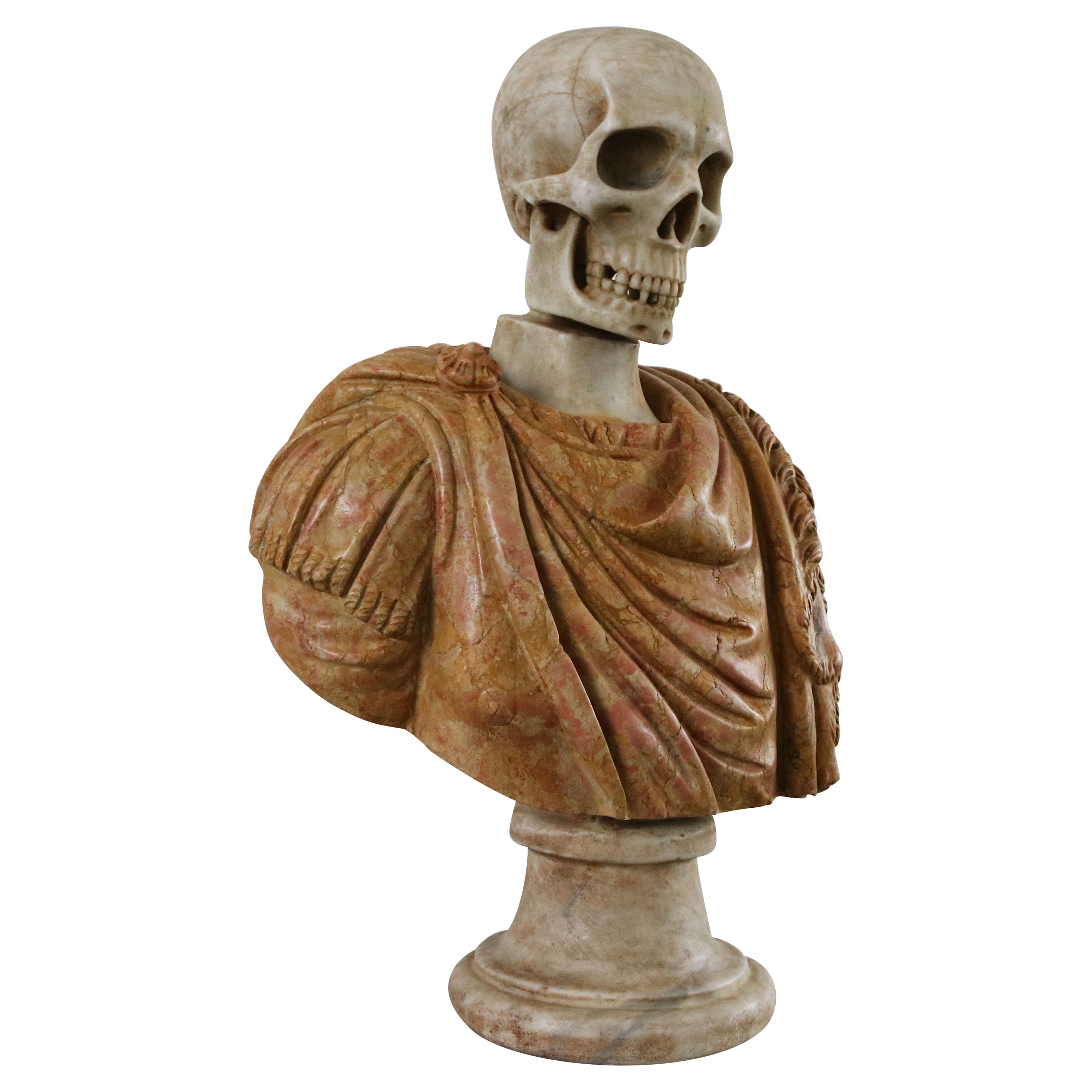Items Similar to Italian Memento Mori skull - 17th century
Want more images or videos?
Request additional images or videos from the seller
1 of 5
Italian Memento Mori skull - 17th century
About the Item
Italian Memento Mori skull
Marble
North of Italy, 17th century
H 9 x L 7 x P 14 cm
At the turn of the 16th century, they were the height of fashion: palm-sized carvings of skulls, that represent status, wealth and the looming specter of death.
Commonly referred to as "memento mori," the objects take their name from a Latin phrase (meaning "remember you must die") that informed popular thinking during the late Middle Ages and early Renaissance. They were collected by social elites -- from upwardly mobile merchants to Europe's most powerful monarchs -- across France, Germany, Belgium and the Netherlands.
Institutions from around the world, including London's Victoria and Albert Museum and the Metropolitan Museum of Art in New York, have contributed examples of the carvings to an impressive collection.
Memento mori were part of a larger cultural moment that emphasized humility, reflection and moral obligation. Traveling preachers would deliver sermons on mortality to peasants in Paris cemeteries, the working class would buy prints on the theme (some of which feature in "The Ivory Mirror") and the rich had their carvings.
It is the type of object that one finds in a kunstkammer, or cabinet of curiosities, so beloved by sixteenth- and seventeenth-century collectors.
- Dimensions:Height: 3.55 in (9 cm)Width: 2.76 in (7 cm)Depth: 5.52 in (14 cm)
- Style:Renaissance (In the Style Of)
- Materials and Techniques:
- Place of Origin:
- Period:
- Date of Manufacture:17th century
- Condition:Wear consistent with age and use.
- Seller Location:Bruxelles, BE
- Reference Number:1stDibs: LU6666230714052
About the Seller
5.0
Vetted Seller
These experienced sellers undergo a comprehensive evaluation by our team of in-house experts.
1stDibs seller since 2022
6 sales on 1stDibs
Typical response time: 7 hours
- ShippingRetrieving quote...Ships From: Bruxelles, Belgium
- Return PolicyA return for this item may be initiated within 3 days of delivery.
More From This SellerView All
- Cerberus, Italy, 17th CenturyLocated in Bruxelles, BECerberus Black painted stone Italy, 17th century Measures: 80 x 69 x 36cm (one head missing) Cerberus, cruel monster, fierce and strange, Through his wide threefold throat barks as a dog Over the multitude immers'd beneath. His eyes glare crimson, black his unctuous beard, His belly large, and claw'd the hands, with which He tears the spirits, flays them, and their limbs Piecemeal disparts (Dante, Inferno, Canto VI). Cerberus figure seated, in his role of ferocious guardian of the underworld; he shows a nervous musculature, an adherent skin which reveals the ribs, long and robust limbs; his heads are broad and the eyes set well apart. Painted in black to amplify his menacing look, the infernal guardian is depicted with his famous attributes, writhing his heads, growling and barking furiously. Cerberus, in Greek mythology, was the monstrous watchdog of the underworld – also known as the “hound of Hades” – preventing the dead from leaving, and making sure that those who entered never left. A child of Typhon and Echidna, he was part of a monstrous family, which included Orthus, the Lernaean Hydra, and the Chimaera as well. Only on three occasions Cerberus was tricked by visitors of Hades: Heracles did it with his strength, Orpheus with his music. In "The Inferno", Dante places Cerberus as the guardian of the third circle of Hell. With his three mouths, Dante saw Cerberus as a beast that was synonymous with the sin of Gluttony. Virgil gets past the monster by throwing mud in his three mouths, temporarily choking him. Very rare are the representations of Cerberus in ancient statuary...Category
Antique 17th Century Italian Renaissance Figurative Sculptures
MaterialsStone
- Alabaster Golgotha, Italy, 17th CenuryLocated in Bruxelles, BEAlabaster Golgotha Italy, 17th cenury Alabaster with traces of polychromy 16 x 10 x 9 cm The Golgotha (literally "Place of the Skull ») is a hill on the outskirts of the city o...Category
Antique 17th Century Italian Renaissance Figurative Sculptures
MaterialsAlabaster
- Marble Lion, Périgord, 17th CenturyLocated in Bruxelles, BEMarble lion white marble France, probably Périgord, 17th century Small marble lion wearing a coat of arms pendant with the engraved date, ...Category
Antique 17th Century French Renaissance Animal Sculptures
MaterialsMarble
- Adoration of the Magi, Flanders, 17th CenturyLocated in Bruxelles, BEThe Adoration of the Magi. Panel carved in high relief. Flanders, 17th century. Measures: 53 x 32,5 cm.Category
Antique 17th Century Dutch Renaissance Figurative Sculptures
MaterialsWood
- A Captive Soldier - Italie (Rome), 17th centuryLocated in Bruxelles, BEA Captive Soldier Gilt Bronze, Lost Wax Italie (Rome), 17th century H 17 x Dia 10 cm H 6 2/3 x Dia 4 inch The 17th century witnessed a flourishing of artistic expression across Eur...Category
Antique 17th Century Italian Baroque Figurative Sculptures
MaterialsBronze
- Large Terracotta Relief - Lombardy, First Half of 17th CenturyLocated in Bruxelles, BELarge Terracotta relief of the flight into Egypt Lombardy, first half of 17th century Painted terracotta 91 x 85 x 11,5 cm This event in the early life of Christ is recounted i...Category
Antique 17th Century Italian Baroque Figurative Sculptures
MaterialsTerracotta
You May Also Like
- 17th c. German Memento Mori Monk c.1600-1699Located in San Francisco, CAABOUT Contact us for more shipping options. Free Bay Area delivery. S16 Home San Francisco. Exceptional large Memento Mori sculpture in polychrome depicting a half flayed Monk. German 17th century. The sculpture presents half of the skeletal face, hand and foot. Shown with life size model...Category
Antique 17th Century German Industrial Figurative Sculptures
MaterialsWood
- German Memento Mori Carved SkullLocated in Newark, EnglandAntique 18th century fruitwood carved Memento Mori Skull. The skull of petrified display powerfully carved in the form of a human skull consisting of the cranium, upper and lower jaws, the cadaverous face with deliberate missing tooth in brown wash patination throughout. Stood upon a small marble base with the skull attaching via a dowel fitting. The Skull probably from German origin. Notes From approximately the sixteenth century, skulls were commonly used to remember death as they symbolise the transience of human life. Memento Mori literal Latin translation means remember that you [have to] die. The concept has its roots in the philosophers of classical antiquity, and appeared in funeral art and architecture of the medieval period. Memento Mori jewellery...Category
Antique 18th Century German Gothic Mounted Objects
MaterialsMarble
- Memento Mori in Wood with Chrismon, Monogram of Christ, Italy End of 17th CentLocated in Milan, ITA Memento Mori in wood with Chrismon, monogram of Christ. Valuable sculpture in fruit wood in almost true-to-life measurements, sculpted with art and finished with a wealth of details. The wood was covered with a thin layer of pellet and finished in color. Immediately above the forehead, in correspondence with the anterior neonatal fontanel, the CHRISMON is painted in purple red. The monogram of Christ or Chi Rho (or CHRISMON) is a combination of letters from the Greek alphabet, which form an abbreviation of the name of Christ. Solar in nature, often inscribed in a circle with multiple rays reminiscent of the cosmic wheel deriving from the ancient solar emblems of Egypt. The symbol consists of two large overlapping letters, the 'X' and the 'P'. They correspond, respectively, to the Greek letter '?' ('chi', which reads kh, aspirated) and '?' ('rho', which reads r). These two letters are the initials of the word '???st??' (Khristòs ), the name of Jesus, which in Greek means "anointed" and translates the Hebrew "messiah". On the sides of these two letters, there are very often two others: one 'a' and one '?', alpha and omega...Category
Antique Late 17th Century Italian Figurative Sculptures
MaterialsWood
- Memento mori, skull with butterfly wings, Germany 1874.Located in Milan, ITA Memento Mori from Wunderkammer, depicting a skull, plaster cast covered with butterfly wings, applied to the crown-shaped skull and to the mosaic-type wooden base. The year 1874 is...Category
Antique 1870s German Figurative Sculptures
MaterialsPlaster, Wood
- Italian Marble Bust Vanitas / Memento Mori 19th Century Carved Sculpture ItalyLocated in Ijzendijke, NLMasterfully carved Italian Vanitas bust in solid marble from late 19th century. White Carrara marble skull combined with a red Rosso Imperiale marble Ro...Category
Antique Late 19th Century Italian Renaissance Revival Busts
MaterialsMarble, Carrara Marble
- Hand Carved Wood Memento Mori Skull Cane Walking Stick HandleLocated in Studio City, CAA fantastic and wonderfully hand carved piece. This smiling, mischievous skull is carved in very fine detail. Would be the crown jewel of any walking stick collection once attached t...Category
20th Century Sculptures and Carvings
MaterialsWood
Recently Viewed
View AllMore Ways To Browse
17th Italian Furniture
Italian 17th
Italy 17th
Italian 17th Century
17th Century Netherlands
17th Century Renaissance
Used Mori
17th Century 17th Mirrors
Italian Late 16th Century
Monarch Century
German 17th Century Furniture
17th Century German Furniture
Memento Mori
Italian Renaissance 17th
Belgian 17th Century
Memento Mori Used
Monarch By Century
Antique Elite Furniture





